SilverStone ML04 & ML05 Slim HTPC Cases Review
by E. Fylladitakis on April 18, 2014 2:30 PM EST- Posted in
- Cases/Cooling/PSUs
- HTPC
- SilverStone
- desktops
Silverstone Milo ML04 Interior
As we mentioned on the previous page, the chassis of the Milo ML04 is made out of 0.8mm SECC steel. As a material, it withstands aging well but the thickness makes it flimsy, even for the narrow surfaces of the slim desktop case. Silverstone however thought ahead and installed two support braces, one at the top left corner and one diagonally across the center of the case. They do a remarkable job of maintaining the mechanical cohesion of the chassis and that becomes apparent once they are removed; when the supports are removed for the installation of components, bending certain parts of the case requires no more strength than that of a small child.
There are several points for cable straps, which ought to help with cable management a little. Silverstone ensures that you will have at least some cable management to do, as the cables of the case itself are peculiarly long, enough for them to easily reach a motherboard sitting on the table behind the case. All of the cables, especially the thicker USB 3.0/audio headers, could and ought to be significantly shorter.
Two cages come pre-installed for holding drives, both of which are removable. The metallic cage to the left side of the case can hold a 5.25" optical drive, or a single 3.5" drive, or two 2.5" drives. In any case, it will have to be removed from the case to install these drives. Beneath the metallic cage, a second 3.5" drive may be installed, mounted on the floor of the case with long screws (provided) inserted from the bottom of the case.
The plastic cage on the right side of the case is an odd design that can hold either a 2.5" or a 3.5" drive. Again, it will have to be removed before you can install the drives, as the mounting screws are inserted from the bottom. It is obvious that Silverstone tried to maintain a level of versatility here by allowing a 3.5" drive to be installed, as the drive will not fit sideways and it has to steer clear of the motherboard. On the other hand, there is already a mounting spot for a 3.5" drive beneath the optical drive bay and thus this plastic bracket appears slightly redundant, as it could have been replaced by a cage capable of holding more than two 2.5" drives.
The interior of the Milo ML04 is not exactly spacious, as Silverstone tries to minimize the depth and height of the case in order for it to fit in with other A/V equipment, but the layout of the case provides very good access when building a system. Due to the layout of the case however, there are several limitations. For instance, you cannot use a PSU longer than 140mm and an optical drive longer than 170mm. Still, even if you adhere to these specifications, the components are so tightly packed that you cannot perform any sensible cable management. As a matter of fact, it is not even possible to attach the cables to an optical drive while it is installed.
Finding a proper PSU for the Milo ML04 is not as easy as it sounds. The chassis needs to be 140mm long (or less) and PSUs with long cables are a curse inside such a case, which rules most high-performance units out of the equation. Using a modular PSU is not a great solution either, not because you will not be able to access the connectors but because the depth they add to the PSU can cause problems, as there is almost no clearance between the PSU and the optical drive. As for the PSU intake, it has a filter installed, accessible from the bottom of the case. The only downside is that the filter is secured with screws, so there is no fast and easy way of cleaning it. Silverstone supplied us with one of their Strider Essential series PSUs for testing, a simple and cost-effective power supply, which appears ideal for such a system.
We can recommend a little trick here; as the power requirements of a typical HTPC system are very low, it might be a good idea to get a low capacity SFX PSU instead. Most SFX PSUs come with ATX adapters, and their chassis is much shorter and thus will allow for much better cable management. Furthermore, a 250-300W SFX PSU will actually be far more efficient, as the power requirements of the system will be within the unit's operational range (all switching PSUs are extremely inefficient if the magnitude of the load is below 20% of their rated capacity).
The installation of a full-size Micro-ATX board inside the Milo ML04 is possible but routing the cables will require nerves of steel. The plastic drive cage will have to be removed in order to access the connectors beneath it. Due to the lack of space, most cables will amass above the bottom right corner of the motherboard, unavoidably creating a mess. There is no clearance between the motherboard and the PSU or the plastic drive cage; it appears that the case was designed to bring everything together as tightly as possible. As for the expansion cards, four low profile cards may be used. It is also possible to use a riser and install a full size single-slot card above the motherboard, but that would also limit the height of the CPU cooler from the already constrictive 70mm down to an absurd 36mm. The installation of any full size mainstream or above gaming graphics card is entirely out of the question.


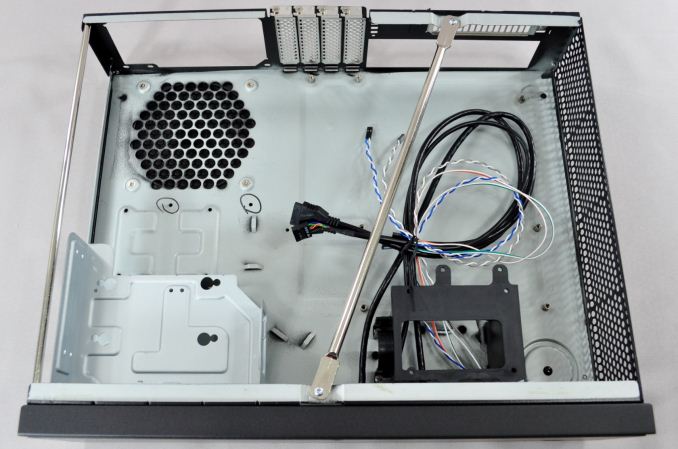






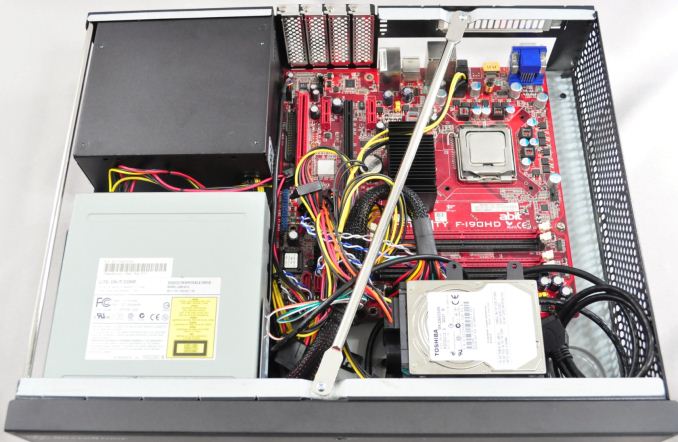
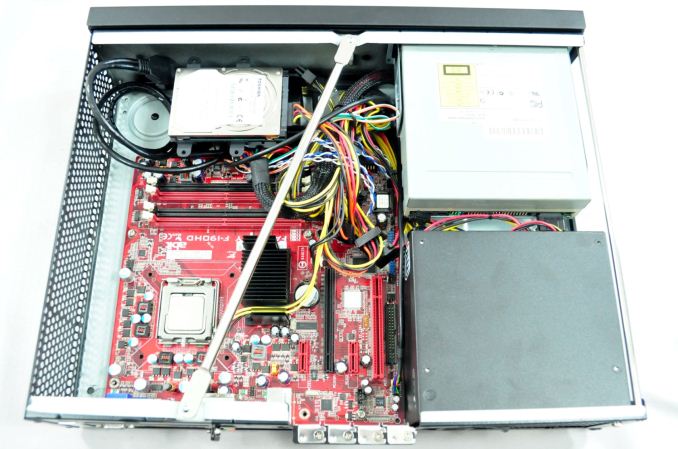
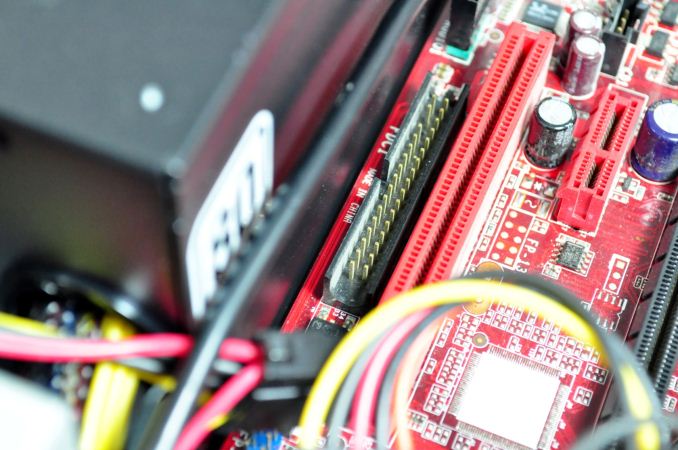
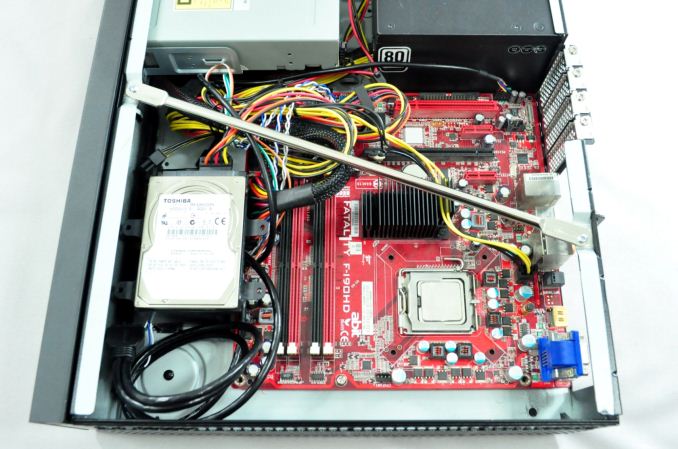








39 Comments
View All Comments
Daniel Egger - Friday, April 18, 2014 - link
I'm not sure I understand the testing method. I just built a HTPC using a Lian Li PC-C50B case. With a Intel Core i5 4440S, a H87 Board, a 300W Be Quiet PSU (the lowest I could get), a GTX 750 Ti OC, a Samsung 840 Pro SSD and 8GB of Crucial XMP 1.3 RAM and the two connected case fans the worst case wall consumption using benchmarks I could get in "performance mode" are around 120W. Your 230W for a far weaker system are sort of ridiculous.BTW: Some further wall values would be 54W for Windows 8.1 Update Login screen, 36W for idle Desktop, 44W for watching Amazon Prime HD content in Firefox.
DanNeely - Friday, April 18, 2014 - link
With a 65W CPU and a >60W GPU (could only find stock TDP) you're probably at least 20 wall watts short of maxing your system out. That doesn't mean that the least unrealistic part of the test was after the fake CPU shut down in the mITX case.Playing around with a few PSU wattage calculators gave 3-6W/dimm. The HDD numbers appear to be for 1/2 3.5" drives; in order to run in spec over 1 or 2 USB ports 2.5" drives would need to consume less than 2.5 or 5W. The only VRM efficiency data I was able to find was for VRMs from a decade ago which were 70-85% efficient under significant loads. And with only half height card slots, the GPU should either be in the 30-40W or not present at all.
Going for a plausible high load config I'd suggest a 75W CPU, 15W VRM (splitting the difference), 12W ram (using the high value for 2 full size dimms), 45W for a GPU and 15W for a 3.5" HDD; total 162W.
At the lower power end, 40W CPU, 8 W VRM, 6W ram (using lower value for sodimm -probably too high), no GPU, and 3W for a 2.5" HDD/SSD; 57W total.
With these cases being sold without any installed fans; meaning they're expecting to be fully cooled by whatever the CPU fan pushes around and what the PSU fan exhausts, something in the 50-90W range is probably about right for a fair test.
Were I a case vendor, with the current test being designed to fail cases designed for medium to low power loads where component fans are intended to do most of the venting, I'd refuse to offer anything except either cases intended for totally fanless operation (eg designs with no room for a GPU and heat pipes running from the included CPU cooler to the chassis) or cases designed for high power over clocking gamers with multiple fans installed at the factory.
Using a tower cooler in a case optimized for a down blowing OEM heatsink, or a blower style GPU in a case designed for an open cooler could result in a few degrees of test result shifting either way. It would still provide more useful information than the current tests which severely penalize all cases except those with huge numbers of factory installed fans. As it stands, the only useful information in the reviews (not available from vendor/retailer pages) now is the subjective data: eg build quality, ease of installation and cable routing, etc.
E.Fyll - Friday, April 18, 2014 - link
Correct; you do not understand the testing method.When performing thermal testing, you induce a constant, passive and significantly greater load than the worst case scenario. Reducing the load would yield similar results anyway, their magnitude would be lower and it would take too many hours to reach a thermal equilibrium. The testing is being performed only in order to provide a basis for proper thermal performance comparisons between similar cases. We can only tell you which case performs better than another, not the exact operating temperatures of every possible configuration that could be installed in it. Trying to correlate the figures of a thermal testing station with the numbers of actual PC's is fundamentally wrong. You cannot correlate with something that you do not know anything about, including (but not limited to) its actual thermal losses, and which not only is active (addition of airflow, sensors and their positions, BIOS programming, etc.) but variable as well.
You cannot use a typical PC to perform any kind of thermal testing. It is an uncontrollable, unknown and active load, with myriads of variables, plus each single system is unique. No matter what results one could get with a single system, no other user would get the exact same results, even if the system were to be identical, let alone a different configuration. Therefore, no matter what kind of numbers I would get by "testing" cases using a typical system, you would only be guessing how your system could correlate to those. Furthermore, I would not be able to compare cases to one another, as that is an active load and introduces myriads of variables that affect the results (you could easily end up with much different comparative results if the configuration of the PC changes). Such a procedure is meaningless.
The figures which you are denoting are the power drain, not the thermal load. These are two different things. The thermal load typically is significantly lower than the power drain. You are mentioning the AC power drain too, most likely read by a very cheap energy meter (unlikely to be the RMS value), not the actual energy consumption of the PC. The actual power drain of your PC probably is 20-50% lower than you think. Be careful with those numbers of yours.
Daniel Egger - Saturday, April 19, 2014 - link
> When performing thermal testing, you induce a constant, passive and significantly greater load than the worst case scenario. Reducing the load would yield similar results anyway, their magnitude would be lower and it would take too many hours to reach a thermal equilibrium.If that is the case you could just use any made up number (what about 1000W?) and check how long it takes until thermal overload. However those figures are completely irrelevant. When buying a case I'd be interested in knowing whether the design is good enough to cool down a reasonably dimensioned system not whether it is better than another system in unrealistic loads, just as DanNeely said.
I'm also not sure why you'd assume that those values can be scaled linearly because we're talking thermodynamics here and those are defined by in some cases very complicated differential equations where even approximate solving (eg. via FEM) can take some time.
> The figures which you are denoting are the power drain, not the thermal load.
I fail to see how they would differ much. With Semiconductors they're usually identical since energy doesn't simply vanish but only transforms into other forms, in this case almost exclusively heat (except for the LEDs and Lasers) and of course power which is consumed outside of the case e.g. to USB devices; but why complicate matters....
> You are mentioning the AC power drain too, most likely read by a very cheap energy meter (unlikely to be the RMS value)
That's a nice assumption but I do have equipment here with proper power factor calculation. And BTW: Even cheap energy meters are nowadays *very* accurate for switching loads >5W with an error of around 0-1%. For most uses it's not required to have a calibrated ZES ZIMMER LMG95 around...
E.Fyll - Saturday, April 19, 2014 - link
No, you cannot use any "made up number", because you will reach a thermal breakdown (much like it happened during the testing of the Milo ML05).I never assumed that the values would scale *linearly*, that's an assumption on your part. Furthermore, using FEM to solve such a complicated system would require days from a large CPU cluster, it is impossible to perform even mundane calculations using a typical computer.
If all energy would convert into heat, then they would not be semiconductors but simple resistors. Semiconductors do work and they require energy for it, which does not get converted to heat. I will not go into the details, you need to expand your knowledge of electronics a lot more before you can understand how the mechanism works if you now believe that all energy will just be converted to thermal.
If you think that cheap energy meters are accurate, then you have no understanding of electric energy at all. Such devices are impossibly inaccurate when used to resolve complex waveforms, especially when these include harmonics. A switching PSU will induce both a phase angle shift and will generate harmonics, thus trying to measure its power drain using such a device is like trying to calculate the distance between the earth and the moon by using a ruler. Their "1% error" suggests that they are at their optimal measuring range and metering a perfectly Ohmic load.
My apologies for the short, vague reply, but I simply do not have the time to give you a much more thorough answer.
Daniel Egger - Saturday, April 19, 2014 - link
> No, you cannot use any "made up number", because you will reach a thermal breakdown (much like it happened during the testing of the Milo ML05).That's sort of my point (and DanNeelys) point. It does not make any sense to test a higher output than a sane system will ever reach.
> I never assumed that the values would scale *linearly*, that's an assumption on your part. Furthermore, using FEM to solve such a complicated system would require days from a large CPU cluster, it is impossible to perform even mundane calculations using a typical computer.
That's very much wrong. For such a simple system of differential equations it would be more like a couple of seconds on current hardware. However you'd need a proper model of each case and proper starting conditions which might take a long time to make up.
> If all energy would convert into heat, then they would not be semiconductors but simple resistors. Semiconductors do work and they require energy for it, which does not get converted to heat. I will not go into the details, you need to expand your knowledge of electronics a lot more before you can understand how the mechanism works if you now believe that all energy will just be converted to thermal.
No, I think you'll need to learn the basics of electronics. Does your CPU move or light up by any chance? How about running hot? And yes, of course there's plenty of resistance in there. You do know how a "transfer resistor" aka transistor works, right?
> If you think that cheap energy meters are accurate, then you have no understanding of electric energy at all.
The German magazine c't conducted a test of 15 power meters somewhen in 2013:
https://www.heise.de/artikel-archiv/ct/2013/21/126...
3 out of 15 sucked rocks while the rest where surprisingly accurate. I do have Fluke True RMS meter and a certified (means good for billing in public networks) smart meter here providing very accurate readings but honestly when my own tests and the c't both say my energy meter is somewhat accurate (+/-1% is good enough) even in tricky cases I don't bother pulling out and connect the complicated gear (not a big fan of having testing probes and other loose electrical connections in the living room where the kids play)...
flashbacck - Friday, April 18, 2014 - link
I'm glad you guys still do the occasional HTPC article. I feel like HTPCs have been dumped for the appleTV's and Roku's of the world. The software scene is so dismal now :(korben44 - Friday, April 18, 2014 - link
Well, as for the software scene and htpcs... I would recommend only one solution.... Xbmcmeacupla - Friday, April 18, 2014 - link
The one thing that keeps me away from these HTPC from silverstone is the slot loading slim BD drive.It costs as much as a BD deck and the BD deck I don't have to buy 3rd party software (that needs to be updated every so often) to use.
Larry Endomorph - Saturday, April 19, 2014 - link
Again with the line charts that are useless to color blind people!?Come on!